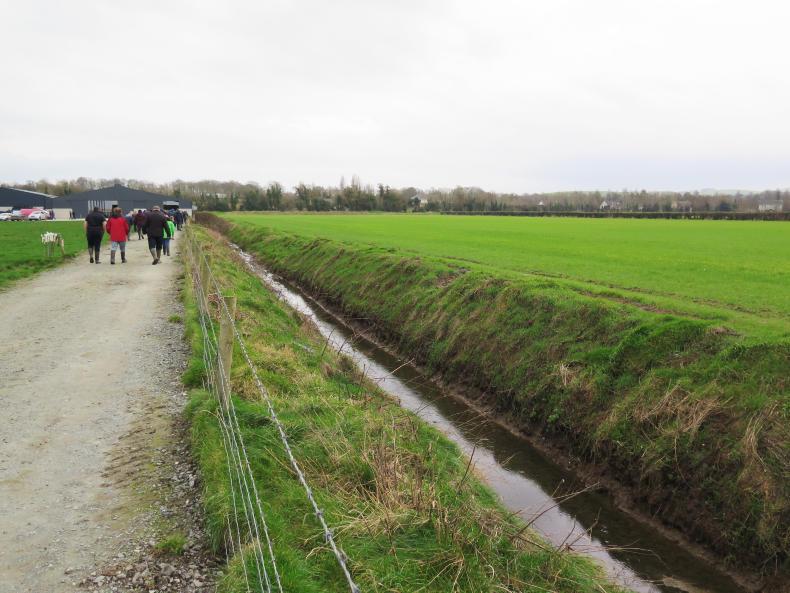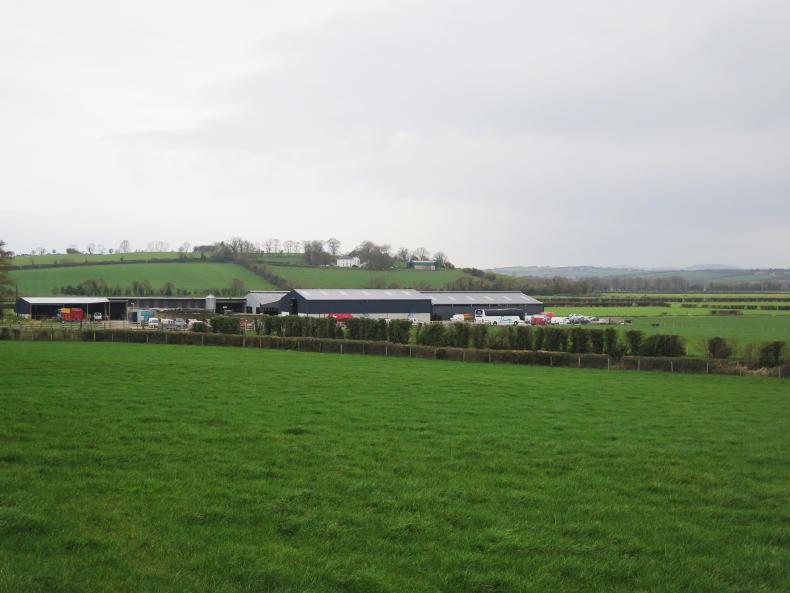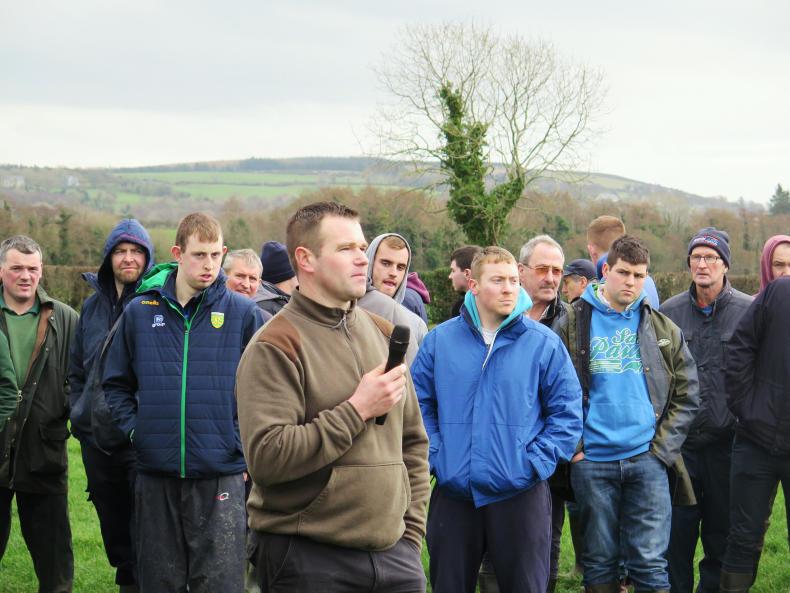Calving has just kicked off in the northwest of Ireland. Last Friday, William Gregg had 12 of his 140 cows calved.
William is farming 39ha near Newtowncunningham in Co Donegal where he hosted a Grass10 farm walk. All the talk was of the great weather; locals were saying the previous 12 months brought the best weather ever experienced.
They escaped the snow of this time last year, the summer and autumn was good and now they are having the best spring in memory.
William’s cows were due to start calving on 20 February and the plan is to turn them out by day initially and then full-time as conditions and grass growth allows.
Local Teagasc adviser Tommy Doherty explained that the Gregg farm was different to most dairy farms in the region, in that there isn’t a huge amount of grass on the farm, due to intensive grazing by geese and swans over the past few weeks.

Remnants of the geese and swans.
The Gregg farm is on the slobs, land that was originally reclaimed from the sea. The land is drained by a series of deep drains which flow through sluice gates out to the sea when the tide is low.

Deep drains lead to the sea.
The Gregg farm is on good-quality, fertile soil. The ground is black but relatively free-draining and you can still see bits of shells mixed in with the soil, all adding to soil organic matter and fertility.
Problem
The problem with the geese and swans grazing off grass is not confined to this farm. It is a problem encountered by many farmers in the region. William’s average farm cover is 750kg/ha, but he says it was a lot more before the birds arrived a few weeks ago. Effectively, they have grazed off a high proportion of the farm and there are very little heavy covers left.
Of the 150 or so people in attendance, only a handful had fertiliser spread on the day of the walk. William didn’t have any chemical fertiliser spread, but he did have 3,000gls/acre of slurry spread on 90% of the land on 15 February. He is going to spread 34kgN/ha across the farm this week.

The Gregg farm yard is very tidy and well laid out.
Farmers were advised to get fertiliser out as soon as possible, when conditions were still good. John Maher from Teagasc said that spreading 30kgN/ha now, would grow enough grass to feed cows on a typical farm for an extra two weeks.
With 140 cows on 39ha, William is stocked at 3.6 cows/ha on the milking block. The overall stocking rate with outside land included is 2.6 cows/ha. Tommy Doherty says the farm would need to be growing 60kg/day and feed 2kg of meal per cow to fully feed the cows.

Teagasc adviser in Donegal Tommy Doherty.
Last year, the cows produced 524kg of milk solids per cow, from 1.1t of meal per cow. William milks late-calving and empty cows through the winter.
Cow numbers increased from 116 last year and a new shed was built to cater for the extra numbers. There are no paddocks on the farm. Instead, the fields are subdivided into four sections using temporary fences.

The large fields on the Gregg farm are subdivided by temporary fences
These can then be taken down when cutting silage and spreading slurry. The temporary fences gives William more flexibility and there are four or five water troughs in each field.
William Gregg is milking 140 cows on a 39ha platform in Newtowncunningham, Co Donegal.Geese and swans are a problem, so turnout will be delayed on this farm.William is spreading 34kgN/ha across the farm this week.Cows will initially be out by day only, on 5kg of meal and silage at night. Read more
Fabulous February sorts feed problems
Six ways to reduce the workload this spring
Calving has just kicked off in the northwest of Ireland. Last Friday, William Gregg had 12 of his 140 cows calved.
William is farming 39ha near Newtowncunningham in Co Donegal where he hosted a Grass10 farm walk. All the talk was of the great weather; locals were saying the previous 12 months brought the best weather ever experienced.
They escaped the snow of this time last year, the summer and autumn was good and now they are having the best spring in memory.
William’s cows were due to start calving on 20 February and the plan is to turn them out by day initially and then full-time as conditions and grass growth allows.
Local Teagasc adviser Tommy Doherty explained that the Gregg farm was different to most dairy farms in the region, in that there isn’t a huge amount of grass on the farm, due to intensive grazing by geese and swans over the past few weeks.

Remnants of the geese and swans.
The Gregg farm is on the slobs, land that was originally reclaimed from the sea. The land is drained by a series of deep drains which flow through sluice gates out to the sea when the tide is low.

Deep drains lead to the sea.
The Gregg farm is on good-quality, fertile soil. The ground is black but relatively free-draining and you can still see bits of shells mixed in with the soil, all adding to soil organic matter and fertility.
Problem
The problem with the geese and swans grazing off grass is not confined to this farm. It is a problem encountered by many farmers in the region. William’s average farm cover is 750kg/ha, but he says it was a lot more before the birds arrived a few weeks ago. Effectively, they have grazed off a high proportion of the farm and there are very little heavy covers left.
Of the 150 or so people in attendance, only a handful had fertiliser spread on the day of the walk. William didn’t have any chemical fertiliser spread, but he did have 3,000gls/acre of slurry spread on 90% of the land on 15 February. He is going to spread 34kgN/ha across the farm this week.

The Gregg farm yard is very tidy and well laid out.
Farmers were advised to get fertiliser out as soon as possible, when conditions were still good. John Maher from Teagasc said that spreading 30kgN/ha now, would grow enough grass to feed cows on a typical farm for an extra two weeks.
With 140 cows on 39ha, William is stocked at 3.6 cows/ha on the milking block. The overall stocking rate with outside land included is 2.6 cows/ha. Tommy Doherty says the farm would need to be growing 60kg/day and feed 2kg of meal per cow to fully feed the cows.

Teagasc adviser in Donegal Tommy Doherty.
Last year, the cows produced 524kg of milk solids per cow, from 1.1t of meal per cow. William milks late-calving and empty cows through the winter.
Cow numbers increased from 116 last year and a new shed was built to cater for the extra numbers. There are no paddocks on the farm. Instead, the fields are subdivided into four sections using temporary fences.

The large fields on the Gregg farm are subdivided by temporary fences
These can then be taken down when cutting silage and spreading slurry. The temporary fences gives William more flexibility and there are four or five water troughs in each field.
William Gregg is milking 140 cows on a 39ha platform in Newtowncunningham, Co Donegal.Geese and swans are a problem, so turnout will be delayed on this farm.William is spreading 34kgN/ha across the farm this week.Cows will initially be out by day only, on 5kg of meal and silage at night. Read more
Fabulous February sorts feed problems
Six ways to reduce the workload this spring











 This is a subscriber-only article
This is a subscriber-only article









SHARING OPTIONS: